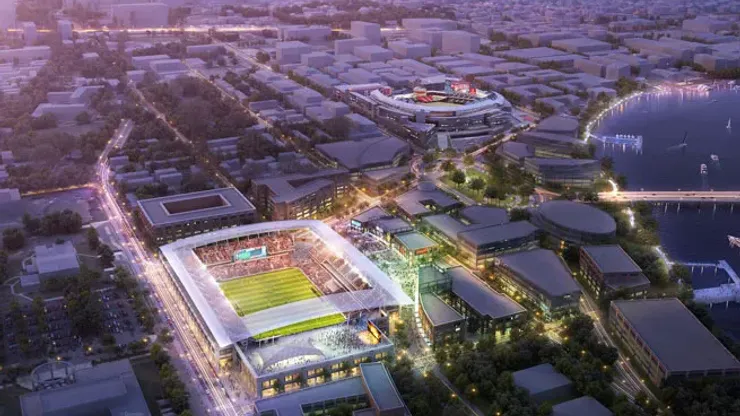The way to tell if someone was a knowledgeable DC United fan has always been to check their opinion on a new stadium. The most diehard, knowledgeable fans always answered with a variation of this phase: “I’ll believe it when I see the shovel hit the ground”.
Since the Columbus Crew opened the first MLS soccer-specific stadium, DC United has been searching for a new home. The site of numerous MLS legendary games as well as multiple men’s and women’s national team games of notes (to say nothing of other sports and cultural events), RFK in a sense is a fitting place for MLS’s most decorated franchise. But while the history is appropriate, almost everything else about the stadium is not. I remember attending an American football game in the late 1990’s, and I was petrified the stadium would collapse on me even then. For a variety of reasons, a major one being its age, RFK had long outlived its usefulness as a sporting venue. The aesthetic is ugly, the infrastructure slowly collapsing, and the accessibility laughable.
Of course the major problem with the stadium is that the city owns it on top of federal property. DCU could never make the stadium and many of the sales on that property into a consistent revenue stream. As the rest of the league surpassed DC in revenue, RFK stood as a model of MLS 1.0, something the league wanted to forget but could not.
This does not mean RFK has been ignored, however, as just last year the U.S. Soccer Federation celebrated its 100th anniversary at RFK against Germany. The stadium has played host to a number of important soccer matches but had finally reached the point where its true state could not be ignored. Baltimore and M&T Bank Stadium have quickly become the mid-Atlantic’s major match site for the men’s national team (with Philadelphia) and DC was quickly losing its slot as a destination for major men’s matches (let’s not even touch Fedex Field).
But now that reality has shifted. Although there is not a shovel in the ground, and there are still one or two hurdles to overcome, the city and team have an agreement to build a stadium in the next few years. For those who have attended so many matches, been the butt of so many jokes, and gazed in envy at the newest temples to the sport, this is a bittersweet day. Soon we too will have a shiny new stadium, one MLS will want to show on TV constantly and will be featured in commercials.
But it’s not just about the stadium, but what it practically means. The team can now go out and invest in players and infrastructure. It’s no secret the team has ben trying to scrape together a workable solution with limited funds, and while sometimes it has succeeded (2014) many times it has failed miserably (2013). With more revenue, the team can invest in designated players, good scouts, and a first class infrastructure in the front office.
As for RFK, the two-year timeline allows us to say goodbye properly. One day the stadium will be razed for an Olympic venue or Redskins stadium, but for now it will likely stand vacant, a graveyard of memories of sports history. RFK will always come with this team, and if the ownership is smart it will incorporate some elements of the old stadium into the new (bouncing stands, color scheme) similar to how large EPL teams do when they build new fields. But over the next two years this team can pay homage to one of soccer’s greatest venues, and that will make saying goodbye easier and make us feel less guilty about lusting after the new site.
In the end, RFK Stadium is like the car many of us had in our 20’s. We probably had it in high school and/or college, and it comes with memories of fun dates, great times with our buddies, and road trips not to forget. But we have a job now, and need to show ourselves as serous professionals, so we need to trade in the old for something more mature, more appropriate for our status. Thus it is with the new stadium. For Christmas, Black and Red fans are getting the present they have long wanted and so rightly deserved.
200+ Channels With Sports & News
- Starting price: $33/mo. for fubo Latino Package
- Watch Premier League, Women’s World Cup, Euro 2024 & Gold Cup
The New Home of MLS
- Price: $14.99/mo. for MLS Season Pass
- Watch every MLS game including playoffs & Leagues Cup
Many Sports & ESPN Originals
- Price: $10.99/mo. (or get ESPN+, Hulu & Disney+ for $14.99/mo.)
- Features Bundesliga, LaLiga, Championship, & FA Cup
2,000+ soccer games per year
- Price: $5.99/mo
- Features Champions League, Serie A, Europa League & Brasileirāo
175 Premier League Games & PL TV
- Starting price: $5.99/mo. for Peacock Premium
- Watch 175 exclusive EPL games per season






